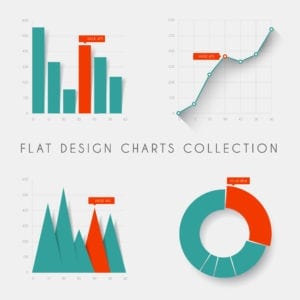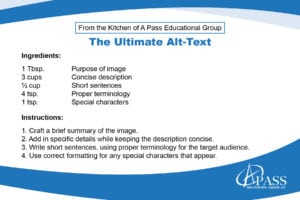When preparing to create an alt-text description, there are several questions a writer should analyze before getting started. Having the answers to these questions will allow the writer to craft a more effective description.
1. What is the purpose of the image?
Different types of images are used for different purposes. Maybe it’s a graph that conveys a relationship between two or more numerical quantities. Or maybe it’s a photograph showing some type of equipment for a procedure. Or it could be a flow chart or other diagram that details a structure or process. Understanding the purpose of an image allows the writer to determine critical information that must be included in the description.
2. Which information can be omitted (if any)?
Is the layout or arrangement of the information critical to understanding the image? Are descriptions such as shape, color, and size important to the message of the image? If not, maybe these types of details can be omitted from the description. For example, in the template shown below, the numbers, icons, and related text would be considered important information for the description. But the circles enclosing the icons, the lines connecting them to the large and small circles, and the color scheme are most likely irrelevant for the alt-text description.

3. What is the correct terminology?
Descriptions should be written with a complexity that is appropriate for the people who may be using them. For images that are included as part of a course or textbook, it’s important to avoid using any terminology that won’t be defined until later in the course. The text that appears before or after the image can provide guidance on the type of language that should be used in the description.
Also, descriptions written for a younger audience will be different from those written for older students and adults. For example, the description of a rectangle for lower grade levels might focus on basic terms such as “sides” or “angles,” while the same shape might be described to older students with additional terms such as “quadrilateral” or “parallelogram.”
4. Can information from the image be described with a list?
If an image contains some type of categorical data, a list of the information may be effective for describing the data. For example, if an image displays the five top-selling items on a retail website, the description might say:
“The 5 top-selling items are A, B, C, D, and E.”
If the image also contained the sales figures for these items, then the description might say:
“The 5 top-selling items, with respective sales figures in dollars, are: A, 900, B, 800, C, 600, D, 400, E, 200.”
This is significantly more concise than the following description “The 5 top-selling items are A, B, C, D, and E. Item A had sales of 900 dollars. Item B had sales of 800 dollars. Item C had sales of 600 dollars. Item D had sales of 400 dollars. Item E had sales of 200 dollars.”

To write great alt-text, follow this recipe.





